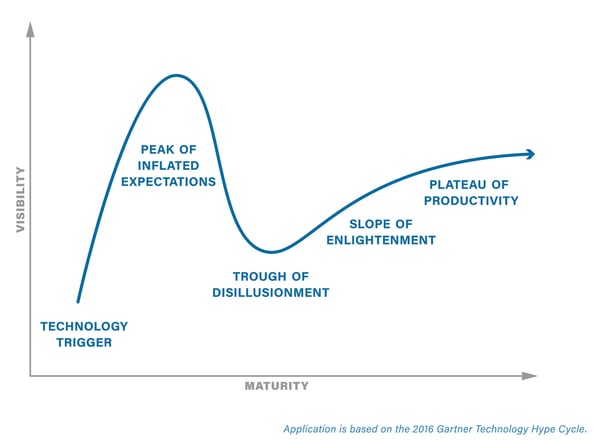Published on
Digital Badges Transforming Non-Credit Education: Credit-Bearing Programming Next

Recognizing and validating learning for non-credit students is a persistent and age-old problem in the postsecondary space. Given the importance of continuous learning to the success and progress of employees today, institutions are now scrambling for a solution and digital badges might just be the silver bullet leaders are seeking. In this interview, Kathleen Radionoff shares her thoughts on the benefits digital badges bear for students, employers and institutions and reflects back on the process she and her team have gone through to help push badges into higher education’s mainstream.
The EvoLLLution (Evo): Why are more and more students turning toward alternative and informal education opportunities?
Kathleen Radionoff (KR): Working adults require lifelong learning to maintain skills in the face of continual changes in technology and work methodology. Alternative and informal education provides just-in-time, targeted skills training. Adults struggle to find the time for training given their work and family responsibilities. Alternative and informal education such as noncredit courses provides the flexibility that they need. Another consideration is the educational attainment of adult students. Approximately 85 percent of our non-credit students already hold a postsecondary credential or degree. Returning to school to earn additional college credits does not make sense for these students. They are not looking for an additional degree, but instead to update and upgrade their skill set.
A 2016 Pew Research Center study found that 63 percent of working adults are professional learners. These learners specifically acquired new or improved job skills with the goal of career advancement. Professional learners use digital technology as well as place-based learning to meet their career goals.
Evo: How do the responsibilities of two-year institutions differ from those of four-year institutions in this regard?
KR: One of the primary missions of two-year schools is to provide workforce training. Two-year schools work closely with local employers to identify training needs and also to provide re-training as needed. Employers can either bring a two-year school into the workplace for customized training or they can send employees to either credit or noncredit classes. Employees can also choose to voluntarily take courses on their own time.
In Wisconsin, two-year schools are nimble and quicker to meet these needs as they arise. Our use of practitioner instructors helps us to quickly become aware of these needs, and put together classes to meet them.
Evo: What does it take to develop a successful alternative credentialing program in the two-year environment?
KR: At Madison College we have been awarding microcredentials in the form of digital badges for almost five years. These badges communicate to the employer what institution awarded the credential, what skill sets the student has successfully demonstrated and how long the credential is valid. Our badges can be shared via email and/or social media platforms such as LinkedIn.
The first step in developing an alternative credential program is to identify your goals and match them to the alternative credential format that makes the most sense. In our case using digital badges to award microcredentials for noncredit learning was a better alternative than trying to launch a MOOC program.
We also needed to build an internal structure and strategies to run a large badging program. This included dedicated faculty resources, branding standards, an operational flowchart and student/instructor training materials on digital badges.
Evo: Why did you and your team decide to launch a badging program at Madison College?
KR: As soon as I read about digital badges, I was very intrigued because I saw an opportunity to offer better credentials to non-credit students. Historically, non-credit is still based on seat time, so if a student shows up for 15 hours, they get a “satisfactory” that is then put on a transcript.
There are several problems with that. First of all, non-credit students don’t typically order their transcripts, so they don’t have any record of their learning. Second, a “satisfactory” doesn’t really communicate to an employer what that student or that job applicant might have learned or what skill sets they have.
With badges, we were able to basically set assessment levels that were high and then, if the student passed those assessments, we were able to award them a digital microcredential that they could embed in social media, an email or a resume. It is a much better system for both non-credit students and potential employers.
Evo: Do you feel that offering an array of digital badges and alternative credentials help to set the college apart when prospective students are looking for a place to enroll, especially for non-credit programming?
KR: Offering digital badges does set colleges apart from the crowd. To my knowledge, we’re the only two-year college in Wisconsin offering digital badges in both credit-bearing and non-credit courses. As Dr. Cathy Sandeen, Chancellor of the University of Wisconsin Colleges and Extension, discussed recently on The EvoLLLution, the UW-Extension has just entered into the realm of badging but we definitely led the way in that initiative.
Evo: What were some of the significant roadblocks you and your colleagues faced in getting your program off the ground?
KR: We started our digital badging program almost five years ago. At that time there were only two technology options available in the United States. The first was the open badging code developed by Mozilla. The second was a badging service offered by a new start-up company. Both of these options had significant downsides for us.
Curriculum and assessment standards also had to be reviewed for every class that we badged. This is a multi-year, intensive process. We needed to ensure that instructors were using the same learning outcomes and assessment standards in every course.
Another obstacle was the need to educate both our instructors and students about digital badges. Badges are still a new concept for most individuals. In the March 2016 article on Lifelong Learning, Pew found that 69 percent of adults were not familiar at all with digital badges and only 16 percent were either somewhat or very familiar with badges.
Evo: How did you overcome those obstacles?
KR: After our first year of badging we found a new technology solution that was significantly more robust than the platform we had been using. This allowed us to significantly ramp up our badging program as well as gather metrics on how the badges were being used by our students.
We are still in the process of reviewing curriculum and assessment standards, course by course. We map curriculum to either industry or employer standards so that the assessment and badge issued are market relevant.
Nationally there is still a major learning curve and the adaptation of badges by both employers and our students. Badging has been successfully implemented by Fortune 100 companies such as IBM but has yet to catch on with mid-sized and small businesses.
Evo: How have students and employers reacted to the program?
KR: Both students and employers have reacted very positively. Our software has analytics that shows us how students are using the badges and they’re sharing them out on social media. We’re currently working with healthcare employers because we’re doing grant work for the American Association of Community Colleges, and the grant is helping us create badges for our medical assistant students. That’s a credit-bearing program but we’re seeing that students are very interested in earning those badges and the healthcare employers that we met with were very intrigued by the additional intelligence. They felt it would be helpful for them when it comes to hiring.
Evo: How do you hope to expand and grow the program over the next few years?
KR: We have over 400 classes and we’re engaged in a multiyear process to go through every single non-credit professional development class, assess the curriculum, work with the instructors and then build a badge.
For any new class that goes online, we’re building badging automatically into it. For our older classes, we are retroactively going back and engaging in this badging process.
Evo: How do you expect to see alternative credentials and badges start to grow across the higher education industry proper over the next few years?
KR: I did an adoption curve that’s based on the Gartner Technology Hype Cycle and basically they have a theory that with any new technology you’ve got this curve that you start out with very high expectations, you get lost, you’re trying to figure out what to do with this technology. Then you go down into what they call a Trough of Disillusionment and then, finally, pieces seem to fit together and it finds an actual productive use for an industry or for a business.
I believe badges are just coming out of the Trough of Disillusionment and they’re now starting to be mainstreamed, as they move up the Slope of Enlightenment. In the U.S. there are a lot of significant national initiatives with some very big names behind them trying to engage in credential transparency and learn more about how employers work with badges. Within the next two years, I think badges are going to become mainstream.

Early on in this process of adopting and offering badges I had a lot of inflated expectations. We got to the point where we realized that neither students nor businesses knew about badges. People want to know more about badges but, until we get through the period of getting people up-to-speed on microcredentials, we’ll be in the Trough of Disillusionment. Then you’ll start to see a cycle-up period as badges become very mainstream. This will move in tandem with the growth in numbers of people who upskill and seek out alternative credentials to accomplish that development.
Evo: Is there anything you’d like to add about the movement towards alternative credentials and badging and role two-year colleges play in taking these to market?
KR: Two-year schools are vocationally focused and many of our occupational programs are starting to look at using badging as a way to recognize and share learning accomplishments. So far, it’s been on the non-credit side but we’ll begin to see badges become widely adopted in the near future.
Madison College has been in badging for a long time compared to others. There were some early adopters like UC Davis-Extension, who experimented with badges as a grant initiative, but when the grant ended they stopped badging. We’ve persevered with badging and there are a few key considerations that people should take to heart when they begin down the badging pathway:
- Why are you badging?
- What type of badging software would make sense for your offerings and institution?
- How do you make badging operational?
How do you tie badging and microcredentials back to the standards you’re trying to badge?
Author Perspective: Administrator
Author Perspective: Community College



